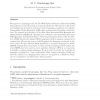Free Online Productivity Tools
i2Speak
i2Symbol
i2OCR
iTex2Img
iWeb2Print
iWeb2Shot
i2Type
iPdf2Split
iPdf2Merge
i2Bopomofo
i2Arabic
i2Style
i2Image
i2PDF
iLatex2Rtf
Sci2ools
94
Voted
CORR
2007
Springer
2007
Springer
Interference Automata
We propose a computing model, the Two-Way Optical Interference Automata (2OIA), that makes use of the phenomenon of optical interference. We introduce this model to investigate the increase in power, in terms of language recognition, of a classical Deterministic Finite Automaton (DFA) when endowed with the facility of interference. The question is in the spirit of Two-Way Finite Automata With Quantum and Classical States (2QCFA) [A. Ambainis and J. Watrous, Two-way Finite Automata With Quantum and Classical States, Theoretical Computer Science, 287 (1), 299311, (2002)] wherein the classical DFA is augmented with a quantum component of constant size. We test the power of 2OIA against the languages mentioned in the above paper. We give efficient 2OIA algorithms to recognize languages for which 2QCFA machines have been shown to exist, as well as languages whose status visa-vis 2QCFA has been posed as open questions. Having a DFA as a component, it trivially recognizes regular languages. ...
CORR 2007 | Education | Optical Interference | Optical Interference Automata | Two-way Finite Automata |
Related Content
| Added | 13 Dec 2010 |
| Updated | 13 Dec 2010 |
| Type | Journal |
| Year | 2007 |
| Where | CORR |
| Authors | M. V. Panduranga Rao |
Comments (0)

